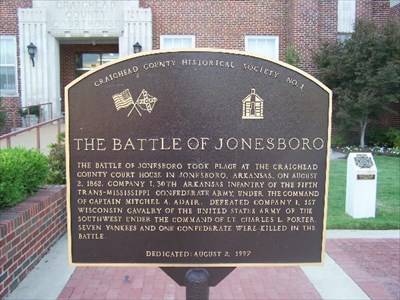Skirmish at Jonesboro
|
Location: |
Craighead County |
 |
|
|
Campaign: |
La Grange’s Expedition into the Arkansas Delta |
||
|
Dates: |
August 1–2, 1862 |
||
|
Principal Commanders: |
Lieutenant Charles Porter (US); Captain Mitchell A. Adair, Captain Edward M. Allen (CS) |
||
|
Forces Engaged: |
Company I, First Wisconsin Cavalry (US); Company I and H, Thirtieth Arkansas Mounted Infantry, and Fourth Missouri Home Guard (CS) |
||
|
Estimated Casualties: |
8 killed, 3 wounded (US); 1 killed (CS) |
||
|
Result: |
Confederate victory |
In 1862, Jonesboro was a small hamlet and the Craighead County seat on Crowley’s Ridge. Captain Mitchell A. Adair, fresh from the Battle of Shiloh and the Battle of Corinth, was sent home to Jonesboro (Craighead County) with some of the Twenty-third Arkansas Infantry for rest and relaxation. Memphis, Tennessee, fell into Union hands in June 1862, and Adair and his men were not able to rejoin the Twenty-third Arkansas on the east side of the Mississippi River.
As there was no local Confederate force to protect local property and citizens, Adair and the men of Craighead County volunteered and helped form Company I of the Thirtieth Arkansas Infantry on July 2, 1862, at Jonesboro. They were assigned to the Fifth Regiment Trans-Mississippi under the command of Major General Thomas C. Hindman.
In late July, Major Henry S. Eggleston of the Second Battalion, First Wisconsin Cavalry, ordered Lieutenant Charles L. Porter to take a detachment north from Wittsburg (Cross County) and survey the counties. Eggleston was under the command of the newly promoted Lieutenant Colonel Oscar H. La Grange and Major General Samuel R. Curtis, commanding officer of the Army of the Southwest. Camped at Wittsburg, Porter foraged and scoured the country in all directions, arresting and examining suspicious characters, relaying dispatches, picking up the sick along the road, removing pockets of resistance, and seizing contraband property. Porter’s orders included taking twenty men of Squadron I, Second Battalion, back to Chalk Bluff in Clay County.
Adair and his men were camped two miles south of Jonesboro. The Confederates had received reports of Union troops coming along the ridge to attack all the county seats in northeast Arkansas. Adair expected the invasion to come from the north, but Porter was traveling north on the old Military Road.
Porter and his men surprised the Confederates by slipping past the pickets, catching the Confederates at rest, and so neither side had casualties. Porter could not wait to report to Eggleston the totals of the first recorded conflict in Craighead County. He had overrun seventy-five Confederates, taking twenty-four prisoners, thirty horses, and three wagons. The rest of the Confederates escaped into the underbrush. The Union soldiers marched their prisoners back to the north up the Military Road to Jonesboro. The First Wisconsin Cavalry locked their prisoners in the new Craighead County Courthouse. The skirmish was one of the few that took place on the grounds of a county courthouse.
All night, the remaining Confederates made plans for the daylight raid. Although the Confederates were outgunned, they had double-barrel shotguns with buckshot and a few good rifles they had seized at Shiloh and Corinth. Federal troops were using Belgian rifles and Springfield muskets, which were better at long range.
The morning of August 2 was hot as the Confederates set up a surprise attack. Adair gave the order to fire, and as the battle raged, the Union troops, who were trying to retreat and hold their ground at the same time, had to keep firing to give their comrades a chance to get to their horses. Some of the Rebels who had been at the Battle of Shiloh had learned the “Rebel yell” and used it so as to confuse the Federals even more. Augustus Ellison of the Fourth Missouri Home Guard was killed by Federal gunfire at the junction of Union Street and Washington Avenue. He was the lone Confederate killed in action. Union soldiers were not expecting an attack—especially one at dawn—and were not familiar with their surroundings, allowing themselves to be run out of town in the confusion. Federal soldiers suffered eight deaths, but in the end, the skirmish proved a rather isolated incident in the Civil War history of Arkansas.
For additional information:
Honnoll, William Danny. “The Battle of Jonesboro, August 2, 1862, Jonesboro, Craighead County, Arkansas.” Jonesboro, AR: W. Honnoll, 1997.
———. “The Battle of Jonesboro and Related Events During the War for Southern Independence.” Craighead County Historical Quarterly 34 (July 1996): 3–16.
Stuck, Charles A. The Story of Craighead County: A Narrative of People and Events in Northeast Arkansas. Jonesboro, AR: 1960.
Williams, Harry Lee. The History of Craighead County. Little Rock: Parke-Harper, 1930.
W. Danny Honnoll
Jonesboro, Arkansas
This article is used with permission from the Encyclopedia of Arkansas History & Culture, www.encyclopediaofarkansas.net.
